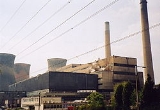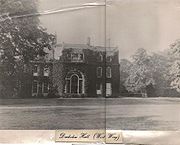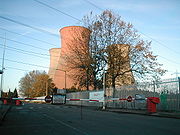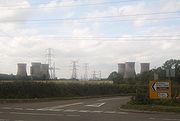
Drakelow Power Station
Encyclopedia
Drakelow Power Station refers to a series of three now demolished coal-fired power stations
located 2.4 mi (3.9 km) south of Burton upon Trent
, Staffordshire
in the West Midlands
of England
, on the River Trent
. However, the station was actually located in the county of Derbyshire
, in the East Midlands
. The power station was a distinguishable landmark of Burton, which is most famous for its breweries.
 The Drakelow power stations were built on the site of Drakelow Hall, a stately home on the south bank of the River Trent
The Drakelow power stations were built on the site of Drakelow Hall, a stately home on the south bank of the River Trent
. Twenty eight generations of the Gresley family
had considered the estate as nothing more than their ancestral home. It had appeared in the Domesday book
and the family could trace its history back to the time of the Norse
Viking
s. A book that was published in 1899, "The Gresleys of Drakelowe", is the accepted history of the family. The hall was demolished in 1934 and its site then earmarked for development in the early 1940s. The remains of the Elizabethan hall occupied part of the site even after the power station was built. The site was chosen for the construction of a power station because it was around 750 acres (3 km²) in size and was within close proximity to the River Trent as well as the main Leicester to Burton railway to the north, the Burton to Tamworth road to the south-east, and was close to the East Midlands
coalfields.
for the construction of the station was granted in March 1950. The £23 Million project was considered a great technological advancement in its day. Rapid progress was being made with the development of larger boiler
s and generator units
. Drakelow A Power Station was commissioned in 1955 and had a capacity of 240 megawatts
(MW). By the time of its opening, work had already started on its larger 480 MW sister, Drakelow B Power Station. It used four 120 MW units and was commissioned between 1959 and 1960. Both the A and B stations were brick
built. The A station had two chimneys each at 360 ft high. B station also had two chimneys (slightly taller) at 400 ft high. They were cooled by four cooling towers each 300 ft high.
The third, final and largest stage of the build was then underway with the construction of Drakelow C Power Station. Work began in 1962 and took two years to complete, beginning generating in 1964. With six larger, 360 ft (109.7 m) cooling towers, two 168 m (551.2 ft) chimneys and two 350MW and two 375MW generators, it dwarfed both the A and B stations put together, having a generating capacity of 1450 MW. This gave the site a total generation capacity of 2170 MW over the three stations, making it the largest electricity generation site in the Europe for a time.

, Cricket
and Rugby
clubs and became part of the community by holding various charity events. Drakelow also proudly boasted a clean accident record. A popular nature trail was housed within the station's grounds.
The station itself did suffer one or two events in its time. A minor fire broke out at the station in the early 1980s and part of C Station was flooded when the River Trent
burst its banks in 2000. Overall however, the station flowed through a rather seamless life.
The Drakelow site's ownership changed hands on several occasions. It was sold to TXU
, an American company, and then in the early 1990s, to Powergen. Powergen were then bought out by E.ON UK
in 2001.
 One of the station's generating sets was taken out of operation in 1995, reducing the stations capacity by 333 MW. There had been talk about the closure of Drakelow C Power Station since late 2002, but E.ON denied the rumours. However, in January 2003, E.ON announced that the station was to close, and on 31 March 2003, the station was decommissioned. It was mothballed soon after and left standing until October 2005. At 05.00 a.m. on 17 November 2005, the two tall chimneys were demolished. By April 2006, the two 170 ft (51.8 m) tall boiler houses had been stripped down to their steel frames, which were demolished at 10.00 a.m. on 27 April 2006.
One of the station's generating sets was taken out of operation in 1995, reducing the stations capacity by 333 MW. There had been talk about the closure of Drakelow C Power Station since late 2002, but E.ON denied the rumours. However, in January 2003, E.ON announced that the station was to close, and on 31 March 2003, the station was decommissioned. It was mothballed soon after and left standing until October 2005. At 05.00 a.m. on 17 November 2005, the two tall chimneys were demolished. By April 2006, the two 170 ft (51.8 m) tall boiler houses had been stripped down to their steel frames, which were demolished at 10.00 a.m. on 27 April 2006.
The six remaining cooling towers were scheduled to be demolished 11.00 p.m. on 19 July 2006. However, the six towers remained standing past their blow down time as a fault with the detonator was found. This was a disappointment for the thousands of spectators which had gathered to see the demolition. A new date for the demolition was set for 20 September 2006 at 10.00 p.m., when the towers finally came down - but again, not without fault. One set of towers came down at 10.00 p.m., but the other three failed after rabbit
s had chewed through the detonation cord. However at 10.50 p.m. the final set of towers came crashing down, ending the era of Drakelow Power Station.
applied for government permission to build a 1,220 MW CCGT gas-fired
power station on the site of the coal-fired stations. It would cost £350 million to construct and would consist of three generating units. On 16 October 2007, Section 36 consent was granted to allow for the construction of the new station. They had planned for construction to begin in 2008, with the goal of having the plant operational by early 2011.Work on these power stations has not yet began. There are also plans to build a biomass-fired power station
on the site. Plans have been put in for 2200 homes to be built on the site and at the same time e-on put in plans to double the size of the plant and now will power 2 million homes. If the plans are accepted it would be up and running by 2017.
Fossil fuel power plant
A fossil-fuel power station is a power station that burns fossil fuels such as coal, natural gas or petroleum to produce electricity. Central station fossil-fuel power plants are designed on a large scale for continuous operation...
located 2.4 mi (3.9 km) south of Burton upon Trent
Burton upon Trent
Burton upon Trent, also known as Burton-on-Trent or simply Burton, is a town straddling the River Trent in the east of Staffordshire, England. Its associated adjective is "Burtonian"....
, Staffordshire
Staffordshire
Staffordshire is a landlocked county in the West Midlands region of England. For Eurostat purposes, the county is a NUTS 3 region and is one of four counties or unitary districts that comprise the "Shropshire and Staffordshire" NUTS 2 region. Part of the National Forest lies within its borders...
in the West Midlands
West Midlands (county)
The West Midlands is a metropolitan county in western central England with a 2009 estimated population of 2,638,700. It came into existence as a metropolitan county in 1974 after the passage of the Local Government Act 1972, formed from parts of Staffordshire, Worcestershire and Warwickshire. The...
of England
England
England is a country that is part of the United Kingdom. It shares land borders with Scotland to the north and Wales to the west; the Irish Sea is to the north west, the Celtic Sea to the south west, with the North Sea to the east and the English Channel to the south separating it from continental...
, on the River Trent
River Trent
The River Trent is one of the major rivers of England. Its source is in Staffordshire on the southern edge of Biddulph Moor. It flows through the Midlands until it joins the River Ouse at Trent Falls to form the Humber Estuary, which empties into the North Sea below Hull and Immingham.The Trent...
. However, the station was actually located in the county of Derbyshire
Derbyshire
Derbyshire is a county in the East Midlands of England. A substantial portion of the Peak District National Park lies within Derbyshire. The northern part of Derbyshire overlaps with the Pennines, a famous chain of hills and mountains. The county contains within its boundary of approx...
, in the East Midlands
East Midlands
The East Midlands is one of the regions of England, consisting of most of the eastern half of the traditional region of the Midlands. It encompasses the combined area of Nottinghamshire, Derbyshire, Leicestershire, Rutland, Northamptonshire and most of Lincolnshire...
. The power station was a distinguishable landmark of Burton, which is most famous for its breweries.
Pre-Construction

River Trent
The River Trent is one of the major rivers of England. Its source is in Staffordshire on the southern edge of Biddulph Moor. It flows through the Midlands until it joins the River Ouse at Trent Falls to form the Humber Estuary, which empties into the North Sea below Hull and Immingham.The Trent...
. Twenty eight generations of the Gresley family
Gresley Baronets
The Baronetcy of Gresley of Drakelow was created in the Baronetage of England on 29 June 1611 for George Gresley of Drakelow Hall, Derbyshire who was later High Sheriff of Derbyshire and Member of Parliament for Newcastle under Lyme .The Gresleys were an ancient Norman family, descended from Nigel...
had considered the estate as nothing more than their ancestral home. It had appeared in the Domesday book
Domesday Book
Domesday Book , now held at The National Archives, Kew, Richmond upon Thames in South West London, is the record of the great survey of much of England and parts of Wales completed in 1086...
and the family could trace its history back to the time of the Norse
Norsemen
Norsemen is used to refer to the group of people as a whole who spoke what is now called the Old Norse language belonging to the North Germanic branch of Indo-European languages, especially Norwegian, Icelandic, Faroese, Swedish and Danish in their earlier forms.The meaning of Norseman was "people...
Viking
Viking
The term Viking is customarily used to refer to the Norse explorers, warriors, merchants, and pirates who raided, traded, explored and settled in wide areas of Europe, Asia and the North Atlantic islands from the late 8th to the mid-11th century.These Norsemen used their famed longships to...
s. A book that was published in 1899, "The Gresleys of Drakelowe", is the accepted history of the family. The hall was demolished in 1934 and its site then earmarked for development in the early 1940s. The remains of the Elizabethan hall occupied part of the site even after the power station was built. The site was chosen for the construction of a power station because it was around 750 acres (3 km²) in size and was within close proximity to the River Trent as well as the main Leicester to Burton railway to the north, the Burton to Tamworth road to the south-east, and was close to the East Midlands
East Midlands
The East Midlands is one of the regions of England, consisting of most of the eastern half of the traditional region of the Midlands. It encompasses the combined area of Nottinghamshire, Derbyshire, Leicestershire, Rutland, Northamptonshire and most of Lincolnshire...
coalfields.
Construction
By the 1940s, the estate was no longer owned by the Gresley family, but by Sir Clifford Gothard. The sale of the land was agreed for a three phase development of electricity generation on the site. Planning permissionPlanning permission
Planning permission or planning consent is the permission required in the United Kingdom in order to be allowed to build on land, or change the use of land or buildings. Within the UK the occupier of any land or building will need title to that land or building , but will also need "planning...
for the construction of the station was granted in March 1950. The £23 Million project was considered a great technological advancement in its day. Rapid progress was being made with the development of larger boiler
Boiler
A boiler is a closed vessel in which water or other fluid is heated. The heated or vaporized fluid exits the boiler for use in various processes or heating applications.-Materials:...
s and generator units
Electrical generator
In electricity generation, an electric generator is a device that converts mechanical energy to electrical energy. A generator forces electric charge to flow through an external electrical circuit. It is analogous to a water pump, which causes water to flow...
. Drakelow A Power Station was commissioned in 1955 and had a capacity of 240 megawatts
Watt
The watt is a derived unit of power in the International System of Units , named after the Scottish engineer James Watt . The unit, defined as one joule per second, measures the rate of energy conversion.-Definition:...
(MW). By the time of its opening, work had already started on its larger 480 MW sister, Drakelow B Power Station. It used four 120 MW units and was commissioned between 1959 and 1960. Both the A and B stations were brick
Brick
A brick is a block of ceramic material used in masonry construction, usually laid using various kinds of mortar. It has been regarded as one of the longest lasting and strongest building materials used throughout history.-History:...
built. The A station had two chimneys each at 360 ft high. B station also had two chimneys (slightly taller) at 400 ft high. They were cooled by four cooling towers each 300 ft high.
The third, final and largest stage of the build was then underway with the construction of Drakelow C Power Station. Work began in 1962 and took two years to complete, beginning generating in 1964. With six larger, 360 ft (109.7 m) cooling towers, two 168 m (551.2 ft) chimneys and two 350MW and two 375MW generators, it dwarfed both the A and B stations put together, having a generating capacity of 1450 MW. This gave the site a total generation capacity of 2170 MW over the three stations, making it the largest electricity generation site in the Europe for a time.

Operations
The Drakelow power stations had a workforce of hundreds of people. The station had its own FootballFootball (soccer)
Association football, more commonly known as football or soccer, is a sport played between two teams of eleven players with a spherical ball...
, Cricket
Cricket
Cricket is a bat-and-ball game played between two teams of 11 players on an oval-shaped field, at the centre of which is a rectangular 22-yard long pitch. One team bats, trying to score as many runs as possible while the other team bowls and fields, trying to dismiss the batsmen and thus limit the...
and Rugby
Rugby football
Rugby football is a style of football named after Rugby School in the United Kingdom. It is seen most prominently in two current sports, rugby league and rugby union.-History:...
clubs and became part of the community by holding various charity events. Drakelow also proudly boasted a clean accident record. A popular nature trail was housed within the station's grounds.
The station itself did suffer one or two events in its time. A minor fire broke out at the station in the early 1980s and part of C Station was flooded when the River Trent
River Trent
The River Trent is one of the major rivers of England. Its source is in Staffordshire on the southern edge of Biddulph Moor. It flows through the Midlands until it joins the River Ouse at Trent Falls to form the Humber Estuary, which empties into the North Sea below Hull and Immingham.The Trent...
burst its banks in 2000. Overall however, the station flowed through a rather seamless life.
The Drakelow site's ownership changed hands on several occasions. It was sold to TXU
TXU
Energy Future Holdings Corporation is an electric utility company headquartered in Energy Plaza in Downtown Dallas, Texas, United States. The company was known as TXU until its $45 billion leveraged buyout by Kohlberg Kravis Roberts, Texas Pacific Group and Goldman Sachs...
, an American company, and then in the early 1990s, to Powergen. Powergen were then bought out by E.ON UK
E.ON UK
E.ON UK is an energy company in the United Kingdom and a subsidiary of E.ON, the world's largest investor-owned power and gas company. As Powergen, it was listed on the London Stock Exchange and was once a constituent of the FTSE 100 Index but since 1 July 2002 has been owned by E.ON AG of...
in 2001.
Closure and Demolition
The A station closed in 1984, and the B station closed in 1993 after surpassing its designed life expectancy. The cooling towers were demolished on 20 December 1998, and by this time the four chimneys and main buildings had also been demolished, leaving only the C Station operating.
The six remaining cooling towers were scheduled to be demolished 11.00 p.m. on 19 July 2006. However, the six towers remained standing past their blow down time as a fault with the detonator was found. This was a disappointment for the thousands of spectators which had gathered to see the demolition. A new date for the demolition was set for 20 September 2006 at 10.00 p.m., when the towers finally came down - but again, not without fault. One set of towers came down at 10.00 p.m., but the other three failed after rabbit
Rabbit
Rabbits are small mammals in the family Leporidae of the order Lagomorpha, found in several parts of the world...
s had chewed through the detonation cord. However at 10.50 p.m. the final set of towers came crashing down, ending the era of Drakelow Power Station.
Future plans
In September 2005, E.ONE.ON UK
E.ON UK is an energy company in the United Kingdom and a subsidiary of E.ON, the world's largest investor-owned power and gas company. As Powergen, it was listed on the London Stock Exchange and was once a constituent of the FTSE 100 Index but since 1 July 2002 has been owned by E.ON AG of...
applied for government permission to build a 1,220 MW CCGT gas-fired
Natural gas
Natural gas is a naturally occurring gas mixture consisting primarily of methane, typically with 0–20% higher hydrocarbons . It is found associated with other hydrocarbon fuel, in coal beds, as methane clathrates, and is an important fuel source and a major feedstock for fertilizers.Most natural...
power station on the site of the coal-fired stations. It would cost £350 million to construct and would consist of three generating units. On 16 October 2007, Section 36 consent was granted to allow for the construction of the new station. They had planned for construction to begin in 2008, with the goal of having the plant operational by early 2011.Work on these power stations has not yet began. There are also plans to build a biomass-fired power station
Biomass
Biomass, as a renewable energy source, is biological material from living, or recently living organisms. As an energy source, biomass can either be used directly, or converted into other energy products such as biofuel....
on the site. Plans have been put in for 2200 homes to be built on the site and at the same time e-on put in plans to double the size of the plant and now will power 2 million homes. If the plans are accepted it would be up and running by 2017.

